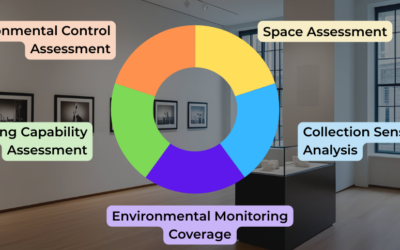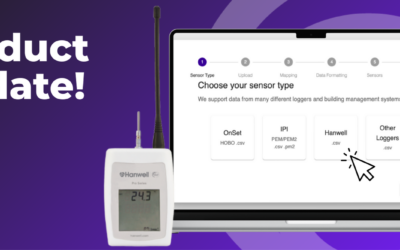LoRaWAN is a wireless communication protocol that enables long-range, low-power, and secure data transmission for Internet of Things (IoT) applications. IoT is merely the interconnection of devices embedded in objects over the internet – like your Google Nest or Apple HomeKit. LoRaWAN data loggers are devices that use LoRaWAN technology to collect, store, and send data from various sensors to a network server or a cloud platform. LoRaWAN data loggers have many advantages over traditional data loggers, such as:
- Batteries that last for years, reducing maintenance costs and environmental impact.
- Coverage over large distances, up to 10 km in rural areas and 2 km in urban areas, without requiring expensive infrastructure or repeaters.
- They can support a large number of sensors and devices, up to thousands per gateway, enabling scalability and flexibility.
- They can provide end-to-end encryption and authentication, ensuring data security and privacy.
So why have you not heard about them before? Due to their practical characteristics, LoRaWAN data loggers have a wide range of applications in other different fields and industries.
LoRaWAN data loggers for agriculture
Agriculture professionals need to monitor various soil and crop parameters, such as soil moisture, temperature, pH, electrical conductivity (EC), nutrient levels, plant growth, pest infestation, and disease occurrence. LoRaWAN data loggers can help agriculture professionals to:
- Collect accurate and timely data from multiple sensors in different fields and plots.
- Transmit the data wirelessly to a central platform, where it can be analyzed and visualized in real-time or historical trends.
- Receive alerts and notifications when the data indicates water stress, nutrient deficiency, or crop health issues.
- Implement precision irrigation, fertilization, pest control, and harvesting based on the data insights.
One example of a LoRaWAN data logger that can be used for agriculture is the SenseCAP S2105 – LoRaWAN® Soil Moisture, Temperature and EC Sensor, which measures soil moisture content (%), soil temperature (°C), soil EC (μS/cm), soil volumetric water content (m3/m3), soil water potential (kPa), soil salinity (g/L), soil total dissolved solids (g/L), soil electrical resistivity (Ω·m). Aren’t you glad that you have fewer variables to worry about? Also, imagine if agriculture professionals were going around their fields picking up USB data loggers once a month! By the time they went by, the crop might already be dead.
Smart cities with LoRaWAN data loggers
Smart city is the concept of using technology and data to enhance the quality of life, efficiency of services, sustainability of resources, and governance of urban areas. Smart city professionals need to monitor various urban parameters, such as air quality, noise level, traffic flow, energy consumption, waste management, and public safety. They will use LoRaWAN data loggers to:
- Collect accurate and comprehensive data from multiple sensors in different locations, such as streets, buildings, parks, and public facilities.
- Receive alerts and notifications when the data indicates environmental pollution, congestion, inefficiency, or emergency situations.
- Implement smart solutions based on the data insights, such as adaptive lighting, traffic management, energy optimization, waste reduction, and even crime prevention.
Intrigued? Check out the SenseCAP A1101 – LoRaWAN Vision AI Sensor. This sensor uses computer vision and machine learning to detect and count objects, such as vehicles, pedestrians, bicycles, and animals.
The industrial Internet of Things
LoRaWAN data loggers can also be used in industry to retrieve data related to industrial processes and systems, such as manufacturing, logistics, energy, and utilities. Industrial IoT professionals need to monitor various industrial parameters, such as temperature, pressure, flow, level, vibration, and current. In addition to the benefits already mentioned above for agriculture and urban planning professionals, industrial engineers can:
- Receive alerts and notifications when the data indicates abnormal conditions, faults, or failures.
- Implement predictive maintenance, quality control, and process optimization based on the data insights. HVAC failures, anyone?
LoRaWAN smart tags for improved healthcare
Healthcare professionals need to monitor various health parameters, such as heart rate, blood pressure, blood glucose, oxygen saturation, and body temperature. LoRaWAN data loggers can help healthcare professionals to:
- Collect accurate and continuous data from multiple sensors in different devices, such as wearable devices, implantable devices, and medical equipment.
- Transmit the data wirelessly to a central platform, where it can be analyzed and visualized in real-time or historical trends.
- Receive alerts and notifications when the data indicates health risks, anomalies, or emergencies.
- Implement preventive and personalized care based on the data insights.
Read this example of how a LoRaWAN smart diaper tag helps caregivers know when it’s time to change a patient for improved quality of life and care.
LoRaWAN data loggers for heritage conservation
As a heritage professional, you may have been used to having to borrow technology developed for other fields. You buy a data logger for a museum or an archive knowing that the device you are buying has really been designed for the pharmaceutical industry, or for the agricultural world. If there were no Conserv, and you wanted LoRaWAN data loggers, this is indeed what you would have to do.
Thankfully, the benefits of the LoRaWAN network can be leveraged for the protection of your collections. There is no jerry-rigging necessary anymore. Conserv sensors are using LoRaWAN natively to send you real-time data on temperature, humidity, lux, and movement. You can be sure you are getting top-of-the-line 21st century technology for your preventative conservation program using a LoRaWAN network coupled with enhanced data analytics.
Conclusions
Why did we bother writing you an article on the uses of LoRaWAN in other fields? We really wanted to drive the point home that a LoRaWAN data logger for heritage conservation is a big deal because you are getting the latest network technology through a bespoke product and platform combination. Given the kind of information you will be collecting, LoRaWAN’s characteristics are perfectly suited for your needs.
LoRaWAN data loggers have many benefits over traditional data loggers, such as long-range, low-power, secure, and scalable data transmission. They are being applied in many different industries to improve decision-making, sustainability, and efficiency. We hope that you give them a try and see if you like them for collections care!
If you have any questions about environmental monitoring, integrated pest management, or just want to talk about preventative conservation, please reach out to us! Don’t forget to check out our blog or join our community of collections care professionals where you can discuss hot topics, connect with your peers or even take a course to get familiar with the Conserv platform.




